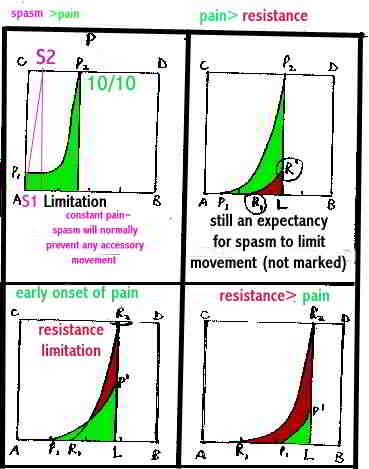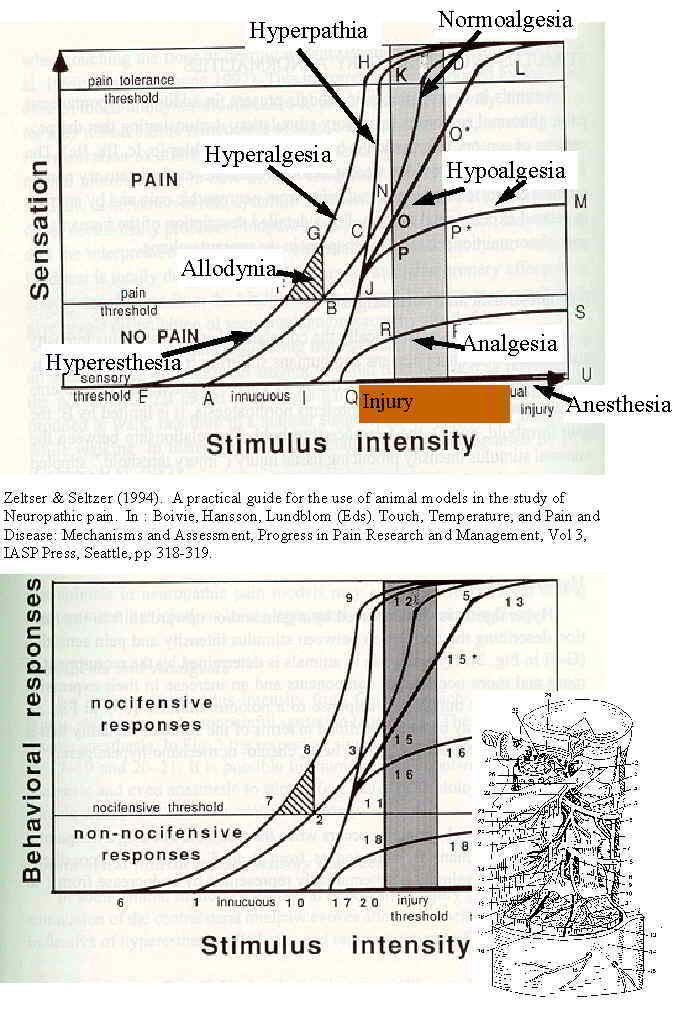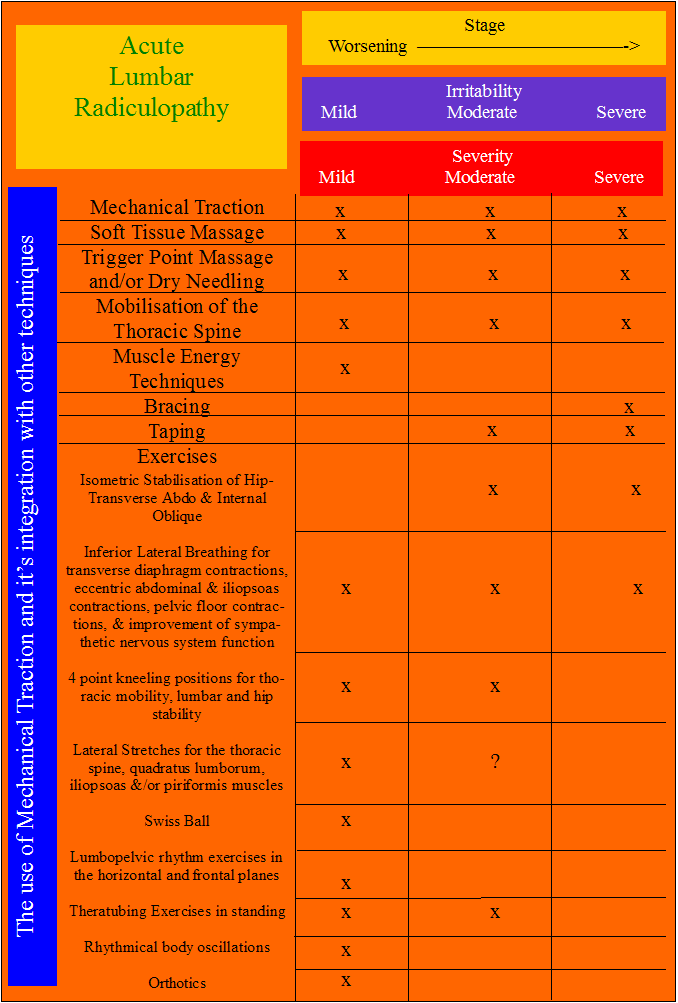Physical Examination and Treatment with Manual Therapy
At Back in Business Physiotherapy, we use joint and nerve mobilisations to alleviate pain.
Passive Accessory Intervertebral Movement (PAIVM's) Diagrams
PAIVM's can be used to assess the relationships between pain, spasm and resistance through joint palpation
Additonally, upslopes, downslopes and even adverse neural tension may have a movement diagram applied to them.
These diagrams may be considered as an aid to the clinical reasoning process to help determine the level of dysfunction.

Acute neck pain: Cervical spine range of motion and position sense prior to and after joint mobilization
Peter J. McNaira, Pierre Porterobc, Christophe Chiquetc, Grant Mawstona, Francois Lavastec
Despite the relatively high prevalence of cervical spine pain, the efficacy of treatment procedures is limited. In the current study, range of motion and proprioception was assessed prior to and after specific cervical spine mobilisation techniques. A 44-year-old male office worker presented with a history of cervical pain of 1 day duration. He had woken with pain, stiffness and a loss of range of motion. Examination findings indicated pain to be at C5–6 on the left side. Measurement of maximal three-dimensional cervical motion was undertaken using a Zebris system. A position matching task tested the individual's ability to actively reposition their head and neck. The treatment undertaken involved grade III down-slope mobilisations on the left side at C5–6 and C6–7 in supine lying. This technique was then progressed by placing the subject in an upright sitting position, and sustained natural apophyseal glides were performed at C6.
Immediately following the treatment, the patient reported a considerable decrease in pain, less difficulty in movement and reduced stiffness. Motion analyses showed the most marked percentage improvements in range of motion after treatment were in flexion (55%), extension (35%), left rotation (56%), and left lateral flexion (22%). Ipsilateral lateral flexion with axial rotation was also notably improved following treatment. No change in proprioceptive ability was found following the treatment. The findings showed that the application of standardised specific mobilisation techniques led to substantial improvements in the range of motion and the restitution of normal coupled motion.
Manual Therapy (2007), 12, 390-394

Neural Dynamics
Neural mobilisations are designed to 'fleece' the nerve thereby improving blood flow into and around the nerve. The following video demonstrates both Mobilisations with Movement and Neural Sliders for elbow pain
Do ‘sliders’ slide and ‘tensioners’ tension? An analysis of neurodynamic techniques and considerations regarding their application
Michel W. Coppieters, David S. Butler
Despite the high prevalence of carpal tunnel syndrome and cubital tunnel syndrome, the quality of clinical practice guidelines is poor and non-invasive treatment modalities are often poorly documented. The aim of this cadaveric biomechanical study was to measure longitudinal excursion and strain in the median and ulnar nerve at the wrist and proximal to the elbow during different types of nerve gliding exercises. The results confirmed the clinical assumption that ‘sliding techniques’ result in a substantially larger excursion of the nerve than ‘tensioning techniques’ (e.g., median nerve at the wrist: 12.6 versus 6.1mm, ulnar nerve at the elbow: 8.3 versus 3.8mm), and that this larger excursion is associated with a much smaller change in strain (e.g., median nerve at the wrist: 0.8% (sliding) versus 6.8% (tensioning)). The findings demonstrate that different types of nerve gliding exercises have largely different mechanical effects on the peripheral nervous system. Hence different types of techniques should not be regarded as part of a homogenous group of exercises as they may influence neuropathological processes differently. The findings of this study and a discussion of possible beneficial effects of nerve gliding exercises on neuropathological processes may assist the clinician in selecting more appropriate nerve gliding exercises in the conservative and post-operative management of common neuropathies.
Manual Therapy (2008), 213-221
Reliability of clinical tests to evaluate nerve function and mechanosensitivity of the upper limb peripheral nervous system
Annina B Schmid, Florian Brunner, Hannu Luomajoki, Ulrike Held, Lucas M Bachmann, Sabine Künzer and Michel W Coppieters
Clinical tests to assess peripheral nerve disorders can be classified into two categories: tests for afferent/efferent nerve function such as nerve conduction (bedside neurological examination) and tests for increased mechanosensitivity (e.g. upper limb neurodynamic tests (ULNTs) and nerve palpation). Reliability reports of nerve palpation and the interpretation of neurodynamic tests are scarce. This study therefore investigated the intertester reliability of nerve palpation and ULNTs. ULNTs were interpreted based on symptom reproduction and structural differentiation. To put the reliability of these tests in perspective, a comparison with the reliability of clinical tests for nerve function was made.
Two experienced clinicians examined 31 patients with unilateral arm and/or neck pain. The examination included clinical tests for nerve function (sensory testing, reflexes and manual muscle testing (MMT)) and mechanosensitivity (ULNTs and palpation of the median, radial and ulnar nerve). Kappa statistics were calculated to evaluate intertester reliability. A meta-analysis determined an overall kappa for the domains with multiple kappa values (MMT, ULNT, palpation). We then compared the difference in reliability between the tests of mechanosensitivity and nerve function using a one-sample t-test.
We observed moderate to substantial reliability for the tests for afferent/efferent nerve function (sensory testing: kappa = 0.53; MMT: kappa = 0.68; no kappa was calculated for reflexes due to a lack of variation). Tests to investigate mechanosensitivity demonstrated moderate reliability (ULNT: kappa = 0.45; palpation: kappa = 0.59). When compared statistically, there was no difference in reliability for tests for nerve function and mechanosensitivity (p = 0.06).
This study demonstrates that clinical tests which evaluate increased nerve mechanosensitivity and afferent/efferent nerve function have comparable moderate to substantial reliability. To further investigate the clinometric properties of these tests, more studies are needed to evaluate their validity.
BMC Musculoskeletal Disorders 2009, 10:11doi:10.1186/1471-2474-10-11 http://www.biomedcentral.com/1471-2474/10/11
Slump stretching in the management of non-radicular low back pain: A pilot clinical trial?
Joshua A. Cleland, John D. Childs, Jessica A. Palmer, Sarah Eberhart
The purpose of this study was to determine if slump stretching results in improvements in pain, centralization of symptoms, and disability in patients with non-radicular low back pain (LBP) with likely mild to moderate neural mechanosensitivity. Thirty consecutive patients referred to physical therapy by their primary care physician for LBP who met all eligibility criteria including a positive slump test but who had a negative straight-leg-raise test (SLR) agreed to participate in the study. All patients completed several self-report measures including a body diagram, numeric pain rating scale (NPRS), and the modified Oswestry Disability Index (ODI). Patients were randomized to receive lumbar spine mobilization and exercise () or lumbar spine mobilization, exercise, and slump stretching (). All patients were treated in physical therapy twice weekly for 3 weeks for a total of 6 visits. Upon discharge, outcome measures were re-assessed. Independent t-tests were used to assess differences between groups at baseline and discharge. No baseline differences existed between the groups (). At discharge, patients who received slump stretching demonstrated significantly greater improvements in disability (9.7 points on the ODI, P<.001), pain (.93 points on the NPRS, ), and centralization of symptoms (P<.01) than patients who did not. The results suggest that slump stretching is beneficial for improving short-term disability, pain, and centralization of symptoms. Future studies should examine whether these benefits are maintained at a longer-term follow-up.
Manual Therapy (2006), 11, 279-286
Neurodynamic responses in children with migraine or cervicogenic headache versus a control group. A comparative study
Harry J.M. von Piekartz, Sara Schouten, Geert Aufdemkampe
Headache in children with unknown aetiology is an increasing phenomenon in industrial countries, especially during growth spurts. During this growth phase, the Long Sitting Slump (LSS) can be a useful tool for measurement of neurodynamics and management. This study investigated the difference in cervical flexion and sensory responses (intensity and location) during the LSS tests in children (n=123) aged 6–12 years, between a migraine (primary headache group=PG), cervicogenic headache (secondary headache group=SG) and control group (CG). The results indicated that the intensities of the sensory response rate were highest in the PG and SG when compared to CG. The responses in the legs were predominantly found in the PG (81.9%) and responses in the spine in the SG (80%). The sacrum position varied significantly between both headache groups (PG and SG) and the CG (p0.05). No significant difference in the neck flexion range was measured in LSS, nor in standardized knee flexion between the PG and CG (p>0.05). The cervical flexion ranges differed significantly (p<0.0001) between the SG on the one hand and the PG and CG on the other. The biggest difference in neck flexion during knee extension was between the SG and CG.
Manual Therapy (2007), 12, 153-160
Clinical Reasoning process




Updated : 29 September 2012


























































































































